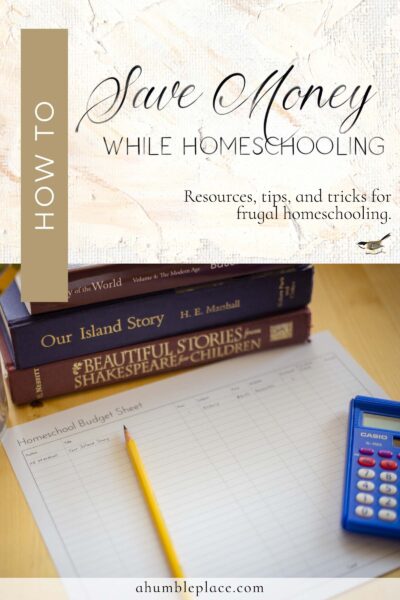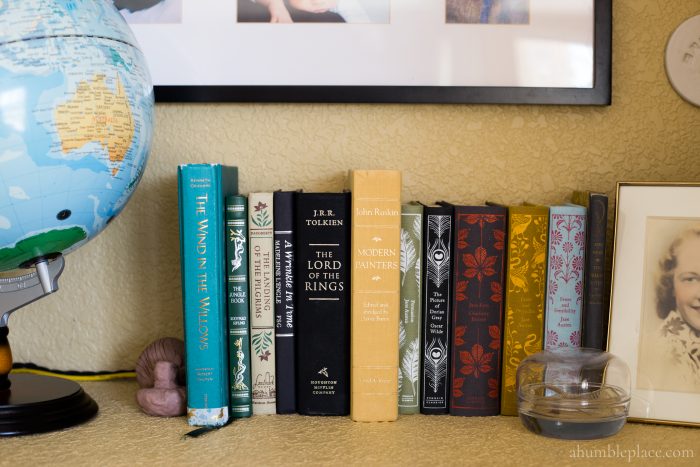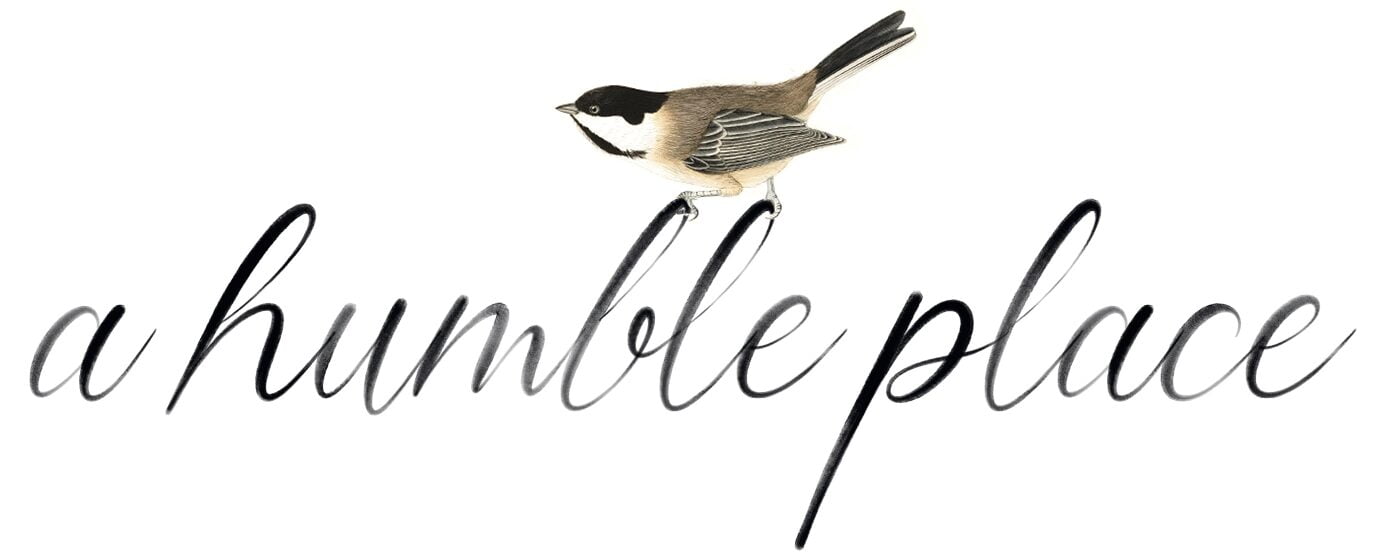How to Save Money While Homeschooling (& free printable book budget sheet!)

With dramatic inflation on the rise in all areas, I thought it was time to revisit this post that I published a few years ago with a few updates about how we save money while homeschooling. There are so many ways to homeschool and, within that, so many ways to save money! With rising costs across the board, it’s important to save those pennies wherever we can!
Books, Curricula, and Supplies
We’ll start with the basics and dive into the things that are required for homeschooling. Those with ebook readers don’t necessarily need to buy physical copies of their books and can save some money on the ones that are in the public domain by getting them from sites like Gutenberg and Archive (the Baldwin Project also has free books online but not in ebook format). However, many of the books you’ll be using most likely won’t be in the public domain, or maybe you’re like me and prefer physical books to ebooks. In that case, here are some ways to save money on books and everything else you’ll need to homeschool.
The Library
The easiest way to save money is to get your school books from the library! Our local library has a loan period of three weeks, but as long as no one else is waiting for the book we’re using, we can renew those items up to eight times, which means we can hold on to one book for 24 weeks. Our interlibrary loan is a little trickier in that we can only have them for a max of six weeks and it can take a while to get something back after you’ve returned it (I know this from personal experience), so that may be something you’ll need to take into consideration. For books that you may only need for a few weeks or one term, this system is ideal. The library also may offer discounts or even free tickets for field trips to local museums and nature centers (ours is called an Adventure Pass), so be sure to ask!
Bookfinder
One of my college professors introduced me to Bookfinder as a good place to find used textbooks, and I’ve been sharing it with others every chance I get ever since. I know that many homeschooling families have their favorite sites for buying used books…Abebooks, Alibris, Biblio, Textbooks, etc. I’ve actually gotten books from all of them at one point or another and the main reason for that is Bookfinder. The beauty of this site is that you put in one book title or ISBN or some other kind of identifier (I find that ISBN or author + title work best), and it searches ALL of those sites as well as Amazon, eBay, and many others for the best price. You can search for new or used books, hardcover or paperback, even first editions, and it’ll show you prices on all of them, including shipping. I have saved a LOT of money on books over the years thanks to this site.
Used Book Sales
Used book sales are a homeschooling family’s best friend. These come in either giant, combined-effort-of-many-different-libraries-a-few-times-a-year form, or as an area or small room in your local library dedicated just to used book sales. Either way, these are a fantastic way to get books. I like to keep a copy of the AmblesideOnline master book list on my phone and when I’m in the library used books room, I can check it when I see a book I think might be scheduled in the future. I’ve honestly been really surprised at some of the books I’ve found at our local library, and I’ve been able to stock up a nice supply of AmblesideOnline books this way. If you’re looking for book sales in your area, Book Sale Finder is a handy site where you can do searches and sign up to receive emails when one is scheduled near you.
eBay
For specific curricula or books that I can’t find through Bookfinder, I use eBay. I have found that the best way to save money on eBay is to set up a search for the particular product I’m looking for FAR in advance of needing it. For instance, in the past, beginning in about October or November, I set up a search for our math curriculum books for the next school year. Any time any products matched that search, I got an email. A few years in a row, one finally came through that was exactly what I was looking for at a great price.
Costco
Costco often has great prices on new books (including sets) as well as lots of office and school supplies. We have gotten pencils, pens, printer paper, construction paper, scissors, tape, printer ink cartridges, 3-ring binders, colored pencils, and many other supplies here for several years and, because it’s usually in bulk, one purchase can last at least one school year, often even longer than that.
Black Friday Sales
These are obviously not going on right now, but in just a few months, the day after Thanksgiving and into Cyber Monday is usually a great time to get deals on homeschool resources. I personally have offered a Black Friday discount on things in my shop (including my Picture Study Aids!) for the last few years, and I know of a few other sites that offer similar resources in other subjects that do the same. (I’ll have a Black Friday post up with more info in the end of November so be sure to subscribe to my newsletter!) A few of the larger companies that sell homeschooling resources that we use also have Black Friday sales, like RightStart Math, Beautiful Feet Books, and Yesterday’s Classics. Last year I ended up buyinga few of our books for the school year we’re in right now just to take advantage of those sales, and they ended up being cheaper than they would’ve been even used.
Discounted Items/Seconds
In my shop, I offer products that are older or very slightly damaged at a discounted rate, and I know of a few other shops that do the same. If you’re okay with items that might be a little less than perfect, take advantage of these discounts!
Subscribe to Newsletters/Social Media
If you buy a lot of homeschool products from a particular site, be sure to sign up for their newsletter and/or follow them on their social media accounts like Facebook, Twitter, and Instagram. Many companies will offer a discount code on first orders when you sign up for their newsletter, and you’ll be the first to know when they have sales at random times of the year!
Online Groups
I’m part of a few local Facebook groups in which members can post their used books and curricula for sale. They list what they have for sale (usually with a picture), and other members of the group can respond in the comments to reserve a specific item. In other online homeschooling groups that I have joined that are not specific to selling things, members also post when book sales are coming in their area (often those that are specific to homeschoolers) which is also helpful. The AmblesideOnline forums also have an entire section dedicated to buying and selling AO books.

Re-Use
If you have more than one child, keep all of your resources for your later children to re-use and look for opportunities to buy a product so that it will last through both kids instead of having to buy a second one later on. When I have the option to buy an ebook version of a workbook, I choose that so I can print it out for both of my kids (as long as that fits within the copyright restrictions of the book – please make sure you are respecting the licensing requests of ebook authors before making copies!). In some cases, you may find that it’s cheaper, in the long run, to pay more for something in the beginning, so you don’t have to buy another version of it later when it’s your next child’s turn. Also, to make sure some of these reusable items last, I highly recommend a laminator!
Borrow from Friends
If you have homeschooling friends near you who have older kids, don’t be afraid to ask if you can borrow some of their physical books (you may also be able to borrow Kindle books but most ebook licensing does not allow for sharing). For my son’s first grade year, which was also the first year we used AmblesideOnline, I was able to borrow the majority of the books from a friend who had already done it which was very helpful.
Paying For It
I think most families keep a homeschool budget, but it’s always nice to be able to find ways to add a little more to that budget. Here are a few ways I’ve managed to pad ours.
Rakuten
I’ve talked about Rakuten before, but I like to mention it anytime online shopping comes up. I have their extension installed on my browser, so any time I’m on a website that offers cash back, I just click a button, and I’m all set. When I get paid, I take that extra money and put it toward our homeschool costs. The added bonus of this is that many of those used books sites I mentioned above with Bookfinder also offer cash back through Rakuten.
Honey
Honey is very similar to Rakuten, except you collect points when you shop on certain sites instead of cash. You can then turn the points in for gift cards at stores like Amazon and use them for homeschool supplies. They also have a pretty handy browser extension that automatically tries coupons for you at certain sites as well. (You should know, however, that you can’t use Honey and Rakuten at the same time, so I usually opt for Rakuten if I have to choose.)
Credit Card Points
If you’re in the habit of paying off your credit card balance in full each month, this is an excellent way to collect credit card points which you can cash out and put toward your homeschool budget. Amazon’s program is particularly profitable if you shop there a lot as all purchases on the site and at Whole Foods get 5% cash back and you can also use that amount toward future Amazon orders for homeschool supplies! (If you’re currently working on paying off credit card debt, I’d skip this option.)
Keeping Track
Of course, you do need to keep track of all those purchases as well, and I use these tools to help me make sure I’m staying within my budget.
You Need a Budget
While I’m a firm believer in the power of having a budget, I’m not yelling at you to have a budget here. You need a Budget (YNAB) is another site that I’ve mentioned before, but I feel it’s worth recommending again and again. YNAB is what I use for budgeting both for our home and my business. Within our household budget, I have a special category just for homeschooling. This helps me keep track not only of what we’re spending but also, whenever I earn extra money from one of the methods I mentioned above, I move that amount into the homeschool budget. It makes keeping track of how much I have available to spend easy!
Book Budget Spreadsheet
I have a special folder in my Google Drive just for school and a subfolder for each year of our school. Within those folders, I have a spreadsheet where I copy all of the books we’ll need for that year from the AmblesideOnline master book list, but I’ve edited it so I can also keep track of the books that we already own, those that are available in ebook form for free, and those that I need to buy as well as a link to where I can buy it, and the price. This helps me keep track of how much money I spend over the course of the year, and when it’s C’s turn to enter that year, I know if I need to buy any other books (eg. a new worksheet book for our math curriculum or new geography maps). You can get a link to the online version or grab the PDF version for your own view in the form below!

I hope this little list has been helpful! If you have any useful tips that you’ve used to save money on homeschooling, leave a comment as I’d love to get more ideas!







Our Costco doesn’t sell books anymore!!! I’m so sad 🙁
I know ours has definitely reduced their offering, but they haven’t gotten rid of them completely!